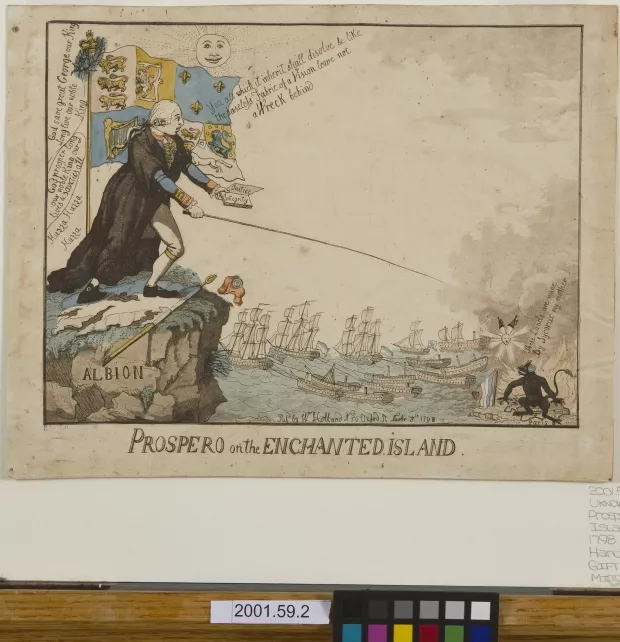Creation Date
1798
Height
32 cm
Width
32 cm
Medium
Genre
Description
George III is portrayed as Prospero the wizard in his long black cloak, holding a book bearing the words “justice” and “integrity” and a long, whip-like wand. He stands on a landmass labeled “Albion,” a tattered French flag under his feet. A gold and blue flag patterned with lions, a harp, and several fleurs-de-lis flies behind him. The sun smiles above his head. On a second, much smaller landmass labeled “Paris,” a black imp (Caliban) wreathed in flame bares its teeth at George. Between them is a river in which ships bearing French and British flags are fighting. George’s caption reads, “Yea all which it inherit shall dissolve & like the baseless Fabric of a Vision leave not a Wreck behind.” Behind him are the words, “God save great George our King,” “Long live our noble King,” “God prosper long our noble King our lives & saveties all,” and “Huzza Huzza Huzza.” Caliban says, “These Lands are mine by Sycorax my mother” (Baker 167).
The French Revolutionary Wars played a significant role in shaping Romantic culture. Political propaganda both for and against the French Revolution was prolifically produced, and caricaturists contributed to this mass of literature by reporting and critiquing the events of the war and the ideas behind it (Donald 142). The Romantic era was also shaped by a revival of older works, such as those by Dante, Milton, and Shakespeare. By using the characters created by these authors, as well as by utilizing the strangeness of their stories, a caricaturist could add yet another layer of interest or meaning to his image. By casting England as Prospero and France as Caliban, the artist here alludes to one of the conflicts of The Tempest: who really owns the enchanted island? The wizard who has claimed it, or the monster, native to the island, who inherited it? This question of ownership is echoed, for the caricaturist, in the British-French conflicts over colonized land (Alexander 4). This caricature of the English victory at the Battle of the Nile casts Britain and France as characters from Shakespeare's The Tempest, consequently finding the significance of the battle in questions of property and colonialism.
Associated Persons
Associated Works
Locations Description
France
The French Revolutionary Wars took place from 1792 to 1802 between the revolutionary government of France and various European nations: first Austria, then the First Coalition (Austria, Prussia, Sardinia, Great Britain, the Netherlands, and Spain), and then the Second Coalition (Austria, Great Britain, Russia, and Turkey). France was at war with Britain continuously from 1793 until the end of the Revolutionary Wars. Napoleon invaded Egypt in 1798, intending to cut off British trade routes to India. By the August of that same year—the year this image was created—Britain had defeated France in the Battle of the Nile, stranding Napoleon's forces in Egypt. This decisive victory not only prevented France from establishing a colony in Egypt, but also gained Britain even more power in there. It is to this significant naval battle that the caricaturist alludes in Prospero on the Enchanted Island(Baker 167).
Abu Qir Bay
The Battle of the Nile took place in the Abu Qir bay in Egypt.
Additional Information
Bibliography
Alexander, Catherine M.S., and Terence Hawkes. The Cambridge Shakespeare Library. Illustrated ed. Vol. II. Cambridge, UK: Cambridge University Press, 2003. Print.
Baker, Kenneth. George III: a Life in Caricature. London: Thames & Hudson, 2007. Print.
Donald, Diana. Age of Caricature: Satirical Prints in the Reign of George III. New Haven: Yale UP, 1996. Print. The Paul Mellon Centre for Studies in British Art.
Morris, William O'Connor, and Andrew Dickson White. The French Revolution and First Empire: An Historical Sketch. New York, 1874. Print.
Shakespeare, William. Select Plays: The Tempest. Ed. William Aldis Wright. Gloucestershire: Clarendon P, 1880. Print.
Thomas, Peter G. D. George III: King and Politicians 1760-1770. Illustrated ed. New York: Manchester UP, 2003. Print.

